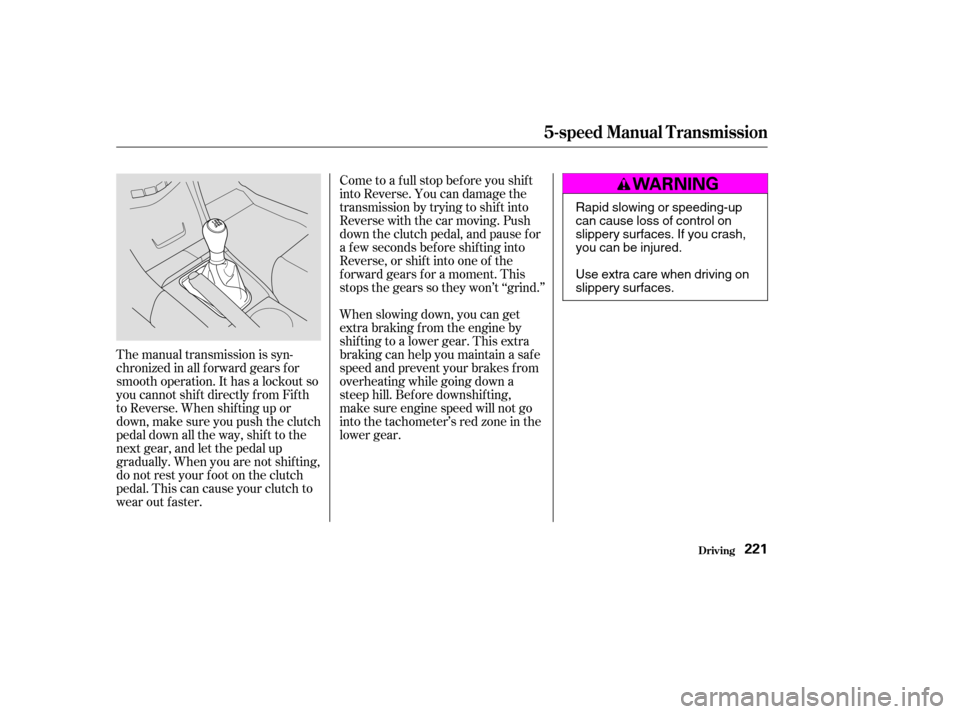Page 113 of 380

To warm the interior:Air conditioning, as it cools, removes
moisture from the air. When used in
combination with the heater, it
makes the interior warm and dry.To remove f og f rom the inside of the
windows:
Set the f an to the desired speed.
Turn on the air conditioning.
Select and Fresh Air mode.
Adjust the temperature control
dial so the mixture of heated and
cooled air f eels comf ortable.
Start the engine.
Select and Fresh Air mode.
Set the f an to the desired speed.
Adjust the warmth of the air with
the temperature control dial.
Once the engine is warmed up, this
setting is suitable f or all driving
conditions. Set the f an to the desired speed.
Select .
When you select , the
system automatically switches to
Fresh Air mode and turns on the
A/C. (The indicator above the
A/C button stays off.)
Adjust the temperature control
dial so the air flow from the
def roster vents f eels warm.
Turn on the rear window def ogger
to help clear the rear window.
When you switch to another mode
f rom , the A/C turns of f .
Butifitwasontostartwith,it
stays on.
1.2.3.4.
1.2.3.4.1.2. 3. 4.
CONT INUED
Heating and Cooling
Comf ort and Convenience Feat ures
T o Heat T o Heat and Dehumidif y wit h A ir
Condit ioningT o Def og and Def rost
117
�����—�����—�����y���������������y���
�(�����������y���
�����y
Page 114 of 380

For saf ety, make sure you have a
clear view through all the windows
bef ore driving away.To shut of f the system temporarily,
turn the fan speed and temperature
control dials all the way to the lef t.
You should shut the system
completely of f only f or the f irst f ew
minutes of driving in cold weather,
until the engine coolant warms up
enough to operate the heater. Keep
the fan on at all other times so stale
air does not build up in the interior.
These settings direct all the air f low
to the defroster vents at the base of
the windshield and the side window
def roster vents. The air f low will get
warmer and clear the windows faster
as the engine warms up. You can
close the side vents with the dial
underneath each vent. This will send
more warm air to the windshield
defroster vents.
To remove exterior f rost or ice f rom
the windshield and side windows
after the car has been sitting out in
cold weather:
Start the engine.
Select .
When you select , the
system automatically switches to
Fresh Air mode and turns on the
A/C. (The indicator above the
A/C button stays off.)
Set the f an and temperature
controls to maximum.
To rapidly remove exterior f rost or
ice f rom the windshield (on very cold
days), f irst select the Recirculation
mode. Once the windshield is clear,
select the Fresh Air mode to avoid
f ogging the windows.
1.2. 3.
Heating and Cooling
Comf ort and Convenience Feat ures
To Turn Everything Of f
118
�����—�����—�����y���������������y���
�(�����������y���
���
�y
Page 115 of 380
CONT INUED
To adjust the air f low f rom the
center vent, move the tab up-and-
down and side-to-side.Thesideventscanbeopenedand
closed with the dials underneath
them.
For the climate control system to
provide heating and cooling, the
engine must be running.
The climate control system draws air
through the exterior vents at the
bottom of the windshield. Keep
these vents clear of leaves and other
debris.
The direction of air f low f rom the
vents in the center and each side of
the dashboard is adjustable.
The automatic climate control
system in your Honda picks the
proper combination of air condi-
tioning, heating, and ventilation to
maintain the interior temperature
you select. The system also adjusts
the fan speed and air flow levels.
On 4-cylinder EX models with lether
interior and EX-V6 models only
Climat e Cont rol Syst em
Comf ort and Convenience Feat ures119
CENTER VENTS TAB
TABS
Close
Open
SIDE VENT
�����—�����—�����y���������������y���
�(�����������y���
�����y
Page 117 of 380

Pressing the OFF button shuts the
climate control system completely
of f . Keep the system completely of f
only f or short periods. To keep stale
air and mustiness f rom collecting,
you should have the f an running at
all times.
To put the Automatic Climate
Control in f ully-automatic mode,
press the AUTO button, then set the
desired temperature by turning the
driver’s temperature control dial.
You will see AUTO in the system’s
display.
The system automatically selects the
proper mix of conditioned and/or
heated air that will, as quickly as
possible, raise or lower the interior
temperature f rom its current level to
the set temperature.
When you set the temperature to its
lower limit (60°F/18°C ‘‘ ’’)
or its upper limit (90°F/32°C
‘‘ ’’), the system runs at f ull
cooling or heating only. It does not
regulate the interior temperature.
When the temperature is set
between the lower and upper limits,
the system regulates the interior
temperature to the set value.
In cold weather, the f an will not
come on automatically until the car
has been driven f or a short time and
the heater starts to develop warm air.
Climat e Cont rol Syst em
Comf ort and Convenience Feat ures
Fully-automatic Operation
Without Navigation System
121
RECIRCULATION BUTTON
OFF BUTTON TEMPERATURE DISPLAY
FAN CONTROL
BUTTONS
AUTO BUTTON
DRIVER’S SIDE
TEMPERATURE
CONTROL DIAL
PASSENGER’S SIDE
TEMPERATURE
CONTROL DIAL
�����—�����—�����y�����������
�
�y���
�(�����������y���
�����y
Page 123 of 380

�Û
�Ý
To put the Automatic Climate
Control in f ully-automatic mode,
press the AUTO button. The
indicator in the button will light.
Then set the desired temperature by
pressing the temperature buttons:
to raise the temperature above the
displayed value, or to lower the
temperature.
The system automatically selects the
proper mix of conditioned and/or
heated air that will, as quickly as
possible, raise or lower the interior
temperature f rom its current level to
the set temperature.
When you set the temperature to its
lower limit (60°F/18°C ‘‘ ’’)
or its upper limit (90°F/32°C
‘‘ ’’), the system runs at f ull
cooling or heating only. It does not
regulate the interior temperature.
When the temperature is set between the lower and upper limits,
the system regulates the interior
temperature to the set value.
In cold weather, the f an will not
come on automatically until the car
has been driven f or a short time and
the heater starts to develop warm air.
Pressing the OFF button shuts the
climate control system completely
of f . Keep the system completely of f
only f or short periods. To keep stale
air and mustiness f rom collecting,
you should have the f an running at
all times.
Climat e Cont rol Syst em
Comf ort and Convenience Feat ures
With Navigation System
Fully-automatic Operation
127
AUTO BUTTON
OFF BUTTON
RECIRCULATION
BUTTON
TEMPERATURE DISPLAY
DRIVER’S SIDE
TEMPERATURE
CONTROL BUTTONS PASSENGER’S SIDE
TEMPERATURE
CONTROL BUTTONS
�����—�����—�����y�����������
�
�y���
�(�����������y���
�����y
Page 215 of 380

Come to a full stop before you shift
into Reverse. You can damage the
transmission by trying to shif t into
Reverse with the car moving. Push
down the clutch pedal, and pause f or
a f ew seconds bef ore shif ting into
Reverse, or shif t into one of the
f orward gears f or a moment. This
stops the gears so they won’t ‘‘grind.’’
When slowing down, you can get
extra braking f rom the engine by
shifting to a lower gear. This extra
braking can help you maintain a safe
speed and prevent your brakes f rom
overheating while going down a
steep hill. Bef ore downshif ting,
make sure engine speed will not go
into the tachometer’s red zone in the
lower gear.
The manual transmission is syn-
chronizedinallforwardgearsfor
smooth operation. It has a lockout so
you cannot shift directly from Fifth
to Reverse. When shif ting up or
down,makesureyoupushtheclutch
pedal down all the way, shift to the
next gear, and let the pedal up
gradually. When you are not shif ting,
do not rest your f oot on the clutch
pedal. This can cause your clutch to
wear out faster.
Driving
5-speed Manual T ransmission
221
Rapid slowing or speeding-up
can cause loss of control on
slippery surfaces. If you crash,
you can be injured.
Use extra care when driving on
slippery surfaces.
�����—�����—�����y���������������y���
�(�����������y���������y
Page 293 of 380
The dust and pollen f ilter is located
behind the glove box.
The dust and pollen f ilter removes
pollen and dust that is brought in
f rom the outside through the heating
andcoolingsystem.
This f ilter should be replaced every
30,000 miles (48,000 km) under
normal conditions. It should be
replaced every 15,000 miles (24,000
km) if you drive primarily in urban
areas that have high concentrations
of soot in the air f rom industry and
diesel-powered vehicles. Replace it
more of ten if air f low f rom the
heating and cooling system becomes
less than usual.
Open the glove box.
To replace it: Push the stop on the right side of
the glove box to detach it from the
glove box.
Pivot the glove box out of the way.
1. 3.
2.
Replacement
Dust and Pollen Filter
Maint enance300
STOP
�����—�����—�����y���������������y���
�(�����������y���������y
Page 336 of 380

If you see steam and/or spray
coming f rom under the hood, turn
of f the engine.
If you do not see steam or spray,
leave the engine running and
watch the temperature gauge. If
the high heat is due to overloading
(climbing a long, steep hill on a
hot day with the A/C running, for
example), the engine should start
to cool down almost immediately.
If it does, wait until the tempera-
ture gauge comes down to the mid-
point then continue driving.
Saf ely pull to the side of the road.
Put the transmission in Neutral or
Park, and set the parking brake.
Turn of f the heating and cooling
system and all other accessories.
Turn on the hazard warning
indicators.
The pointer of your car’s tempera-
ture gauge should stay in the mid-
range under most conditions. It may
go higher if you are driving up a long
steep hill on a very hot day. If it
climbs to the red mark, you should
determine the reason.
Your car can overheat f or several
reasons, such as lack of coolant or a
mechanical problem. The only
indication may be the temperature
gauge climbing to or above the red
mark. Or you may see steam or
spray coming f rom under the hood.
In either case, you should take
immediate action. 1.
2. 3.
CONT INUED
If Your Engine Overheats
T aking Care of t he Unexpect ed345
Steam and spray from an
overheated engine can
seriously scald you.
Do not open the hood if steam
is coming out.
Driving with the temperature gauge
pointer at the red mark can cause
serious damage to your engine.
�����—�����—�����y���������������y���
�(�����������y���������y